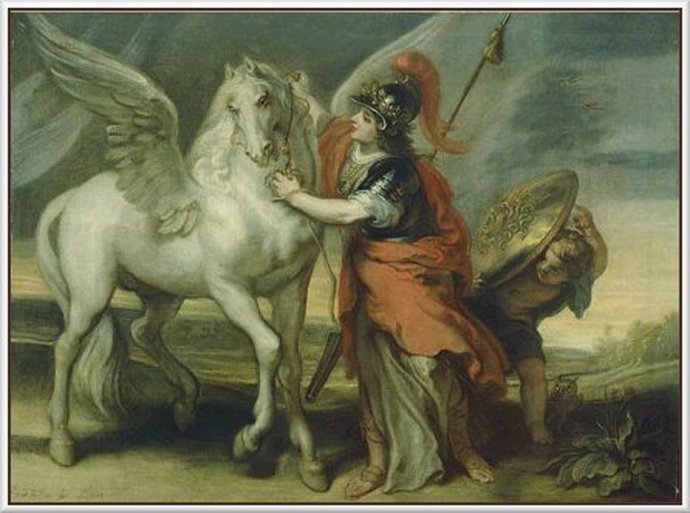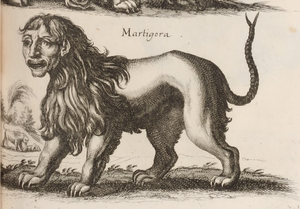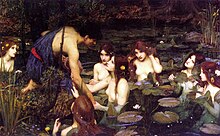Mountains
ChimeraA hybrid creature composing of the body of a lion with the additional head of a goat and a snake (head and all) as the tail. It is the child of Typhon and Echidna and the sibling of Cerebus and the Hydra. The chimara has the ability to breathe fire. It is native to mountains of Lycia in modern-day Turkey and most specifically on Mount Chimaera which in real life is known to have constantly burning flames on its surface which are most visible at night. The chimera is usually depicted as a female though oddly enough even with it's female anatomy present, it is always potrayed with a full mane. Centaur
A creature with the lower half of a full hourse with the upper half of a humanoid in place of it's head. They were usually depicted as brutal and highly aggresive although this isn't true for every centaur. Their violence only got worse if they were drunk and unlike their bipedal cousins, satyrs, centaurs were thought to pose a genuine threat to humans. Centaurs lived in wooded mountains though their location changed a bit throughout the years. A female centaur is called a centauride. Griffin
A hybrid of an eagle and a lion often with pointed ear tufts and sometimes with leopard-esque spots (very rare?). The subspecies of griffin from India were described in high detail of being the size of a wolf, with the legs and claws of a lion and colorful plumage: black feathers across most of their body, red breast feathers, blue neck feathers, and white wings. Indian Griffins were also described as not being the greatest at long flight however they were able to attack in flight and gets the better lions, dragons, and tigers. Griffins lived inmountains gold deposits and were very well known for their affinity for gold which many would travel to steal. They also like to eat horses. Cyclops

Forests
SatyrA hybrid with the lower half of a horse (or goat) and a humanoid upper half. They are often potrayed as lustful to the degree that the word for a man with an obsession with sex is a satyromaniac. Along with their perverted tendencies they have been known to very frequently harass non-consenting nymphs (ick) despite their intense and excessive interest in sex they are almost never shown to be as violent as centaurs. A female satyr is called a satyress but they were created by Post-Roman artists and not in the original greek mythology as satyrs are shown to be exclussively male (however I prefer to think of them having a female counterpart).
Seas
SirenVery simular to the harpy, Sirens are human-headed birds with the difference between them being the sirens seductive voice used to lure men at sea. Writer Walter Copland Perry wrote that "Their song, though irresistibly sweet, was no less sad than sweet, and lapped both body and soul in a fatal lethargy, the forerunner of death and corruption". In later interpretations of the creature they have become more of a hybrid between a woman and a fish as opposed to with a bird (possibly to distingush it from a harpy). Strangely enough you can actually SEE the transition from bird to fish in old bestiaries where some were potrayed as woman-fish-bird hybrids! While not technically aquatic (as birds), they did live on cliffsides and rocky areas right at the seaside. Charybdis
Hippocampus

Caves
HarpyVicious winged women who were the personification of strong winds. Sometimes they were said to be beautiful and other times said to be horrific in appearance. They were strong enough to pick a grown man off of the ground and could snatch things off without a trace. In one story they stole people's food continuously. In some accounts they lived in the islands of western greece and in others they lived in the islands of Crete (nested in caves) or Thrace.
Jungles
ManticoreLion bodied with a humanoid face, scorpion tail, or with a tail of poisonous spines that could be shot out at will (instantly fatal). They have been potrayed with deep red fur, three rows of teeth , and a voice that sounds like a panflute mixed with a trumpet. They lived in India and Aetheopia. Its Persian name translates to Man-eater.
Swamps
HydraStymphalian bird

Underworld
CerberusThree headed gaurd dog of the underworld and servant of Hades. It was originally depicted with a mane of snakes along with its heads. Cerberus was once taken out of the underworld unwillingly by Herecles and opun seeing the light of day for the first time in its life, it either threw up or foamed out toxic bile which grew into Wolf's Bane. Gorgons
Gorgons are serpentine women, the most famous of which were Medusa and her sisters. The gorgons are famously depicted as having venomous snakes as locks of hair and a stone-turning gaze (the snakes themselves also share this ability).They also had wings, brazen claws, the tusks of boars, and scaly skin in some depictions.Gorgons are typically immortal (although Medusa herself wasn't). It is said that blood taken from the left side of their body is instantly fatal while blood from the right side has healing properties. Gorgons live by the entrance of the underworld.
Other
NymphFeminine nature spirits tied to and personifiying specific landforms and places. They wre not immortal but lived much longer than humans. I am not catorgarizing them by habitat as that would be tedious since there are MANY subtypes of nymph for many different environments. They are noted for being beautiful maidens. Sphinx
A hybrid of a human, a lion, and sometimes a bird. The sphinx is featured in a number of mythology but plays a large role in greek mythology. They were very well known for their riddles (especially and individual sphinx that terrorized Thebes). The Sphinx in Thebes began killing many important people until (mother-loving) Oedipus solved her riddle and ended her cruel shenanigans. iconic. Akephaloi / Blemmyae
A race of headless people with faces on their chests. They were featured widely in european folklore and were said to live by the nile river in ancient Libya and ancient "aetheopia" (Sudan / upper Nile river). A very interesting sight. Hecatoncheires
Minotaur
Pegasus

 A creature with the lower half of a full hourse with the upper half of a humanoid in place of it's head. They were
usually depicted as brutal and highly aggresive although this isn't true for every centaur. Their violence only got
worse if they were drunk and unlike their bipedal cousins, satyrs, centaurs were thought to pose a genuine threat to
humans. Centaurs lived in wooded mountains though their location changed a bit throughout the years. A female centaur
is called a centauride.
Griffin
A creature with the lower half of a full hourse with the upper half of a humanoid in place of it's head. They were
usually depicted as brutal and highly aggresive although this isn't true for every centaur. Their violence only got
worse if they were drunk and unlike their bipedal cousins, satyrs, centaurs were thought to pose a genuine threat to
humans. Centaurs lived in wooded mountains though their location changed a bit throughout the years. A female centaur
is called a centauride.
Griffin
 A hybrid with the lower half of a horse (or goat) and a humanoid upper half. They are often potrayed as lustful to
the degree that the word for a man with an obsession with sex is a satyromaniac. Along with their perverted tendencies
they have been known to very frequently harass non-consenting nymphs (ick) despite their intense and excessive interest
in sex they are almost never shown to be as violent as centaurs. A female satyr is called a satyress but they were
created by Post-Roman artists and not in the original greek mythology as satyrs are shown to be exclussively male
(however I prefer to think of them having a female counterpart).
A hybrid with the lower half of a horse (or goat) and a humanoid upper half. They are often potrayed as lustful to
the degree that the word for a man with an obsession with sex is a satyromaniac. Along with their perverted tendencies
they have been known to very frequently harass non-consenting nymphs (ick) despite their intense and excessive interest
in sex they are almost never shown to be as violent as centaurs. A female satyr is called a satyress but they were
created by Post-Roman artists and not in the original greek mythology as satyrs are shown to be exclussively male
(however I prefer to think of them having a female counterpart).
 Lion bodied with a humanoid face, scorpion tail, or with a tail of poisonous spines that could be shot out at will
(instantly fatal). They have been potrayed with deep red fur, three rows of teeth , and a voice that sounds like a
panflute mixed with a trumpet. They lived in India and Aetheopia. Its Persian name translates to Man-eater.
Lion bodied with a humanoid face, scorpion tail, or with a tail of poisonous spines that could be shot out at will
(instantly fatal). They have been potrayed with deep red fur, three rows of teeth , and a voice that sounds like a
panflute mixed with a trumpet. They lived in India and Aetheopia. Its Persian name translates to Man-eater.

 Feminine nature spirits tied to and personifiying specific landforms and places. They wre not immortal but lived much longer
than humans. I am not catorgarizing them by habitat as that would be tedious since there are MANY subtypes of nymph for many
different environments. They are noted for being beautiful maidens.
Sphinx
Feminine nature spirits tied to and personifiying specific landforms and places. They wre not immortal but lived much longer
than humans. I am not catorgarizing them by habitat as that would be tedious since there are MANY subtypes of nymph for many
different environments. They are noted for being beautiful maidens.
Sphinx
 A race of headless people with faces on their chests. They were featured widely in european folklore and were said to live by
the nile river in ancient Libya and ancient "aetheopia" (Sudan / upper Nile river). A very interesting sight.
Hecatoncheires
A race of headless people with faces on their chests. They were featured widely in european folklore and were said to live by
the nile river in ancient Libya and ancient "aetheopia" (Sudan / upper Nile river). A very interesting sight.
Hecatoncheires